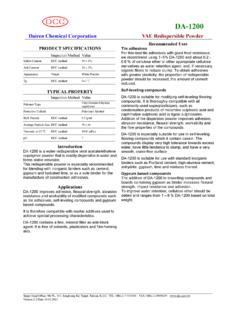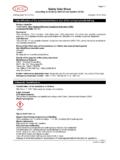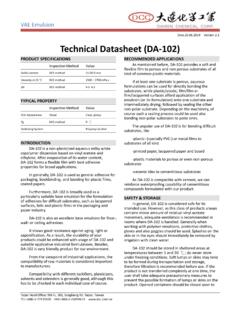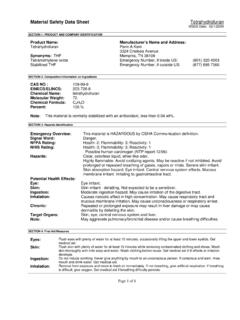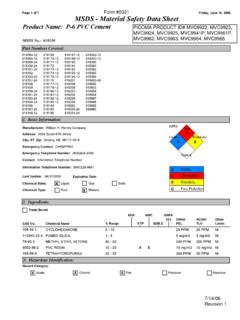Transcription of Page 1/8 Safety Data Sheet - dcc.com.tw
1 Page 1/8 Safety data Sheetaccording to Globally Harmonized System (GHS)Printing date : Identification of the substance/mixture and of the company/undertaking Product identifier Trade name:1,4-Butanediol (1,4-BDO) Synonyms:Butane-1,4-diol, BDO, BD, 1,4-Butylene Glycol , 1,4-Dihydroxybutane, Tetramethylene glycol, Butyleneglycol, 1,4-Butanediol, Tetramethylene 1,4-diol, Butanediol, 1,4-Tetramethyl glycol, Diol 14B, Sucol B CAS Number:110-63-4 Relevant identified uses of the substance or mixture and uses advised against: Identified/Recommended uses:Raw Material for:Manufacturing of Poly-butylene Terephthalate (PBT), Polyurethane (PU),Tetrahydrofuran (THF), Polytetra-methylene-ether-glycol (PTMEG), -butyrolactone (GBL), Poly-ester plasticizers, PU chain extender, carriersolvent in printing ink, key component of hot melt adhesive, and cleaning agent. Uses advised againstAny use in cosmetic productsSoluble coatings on children's toys Details of the supplier of the Safety data Sheet Manufacturer/Supplier:Dairen Chemical Corporation9th Fl.
2 , No. 301, SongJiang City, 10483, TAIWANTel: +886-2-7743-1500 Fax: + Further information obtainable from:Respective plant's environmental, health, and Safety (EHS) Dept. Emergency telephone number:+886-2-7743-1500 (08:30-17:30; GMT+8)2 Hazards identification Classification of the substance or mixtureAcute Tox. 4 H302 Harmful if SE 3 H336 May cause drowsiness or dizziness. Label elements GHS label elementsThe substance is classified and labelled according to the Globally Harmonised System (GHS). Hazard pictogramsGHS07 Signal wordWarning Hazard-determining components of labelling:butane-1,4-diol Hazard statementsHarmful if cause drowsiness or dizziness. Precautionary statementsAvoid breathing dust/fume/gas/mist/ thoroughly after not eat, drink or smoke when using this SWALLOWED: Call a POISON CENTER/doctor if you feel INHALED: Remove victim to fresh air and keep at rest in a position comfortable for breathing.
3 (Contd. on page 2) GHS Page 2/8 Safety data Sheetaccording to Globally Harmonized System (GHS)Printing date : name:1,4-Butanediol (1,4-BDO)(Contd. of page 1) in a well-ventilated place. Keep container tightly Composition/information on ingredients Chemical characterisation: Substances CAS No. Description110-63-4 butane-1,4-diol Identification number(s) EC number:203-786-54 First aid measures Description of first aid measures General information:Symptoms of poisoning may even occur after several hours; therefore medical observation for at least 48hours after the accident. After inhalation:Supply fresh air; consult doctor in case of complaints. After skin contact:Rinse cautiously with water for several minutes. After eye contact:Rinse opened eye for several minutes under running water. After swallowing:Rinse out mouth and then drink plenty of not induce vomiting; call for medical help for a doctor immediately.
4 Most important symptoms and effects, both acute and delayedDiszinessNauseaHeadacheVomitingBl urred visionCNS disordersParalysis symptoms Indication of any immediate medical attention and special treatment neededTreatment of exposure should be directed at the control of symptoms and the clinical condition of Firefighting measures Extinguishing media Suitable extinguishing agents:Use fire extinguishing methods suitable to surrounding conditions. Special hazards arising from the substance or mixtureVapours are heavier than air and may spread along explosive mixtures with air at elevated of hazardous combustion gases or vapours possible in the event of fire. Advice for firefighters Protective equipment:Wear positive-pressure self-contained breathing apparatus (SCBA) and protective fire fighting clothing(includes fire fighting helmet, coat, trousers, boots, and gloves).
5 Wear self-contained respiratory protective device. Additional informationCool endangered receptacles with water spray. GHS (Contd. on page 3)Page 3/8 Safety data Sheetaccording to Globally Harmonized System (GHS)Printing date : name:1,4-Butanediol (1,4-BDO)(Contd. of page 2) Accidental release measures Personal precautions, protective equipment and emergency proceduresEnsure adequate ventilationDo not breathe dust/fume/gas/mist/ respiratory protective device against the effects of fumes/dust/aerosol. Environmental precautions:Dilute with plenty of not allow to enter sewers/ surface or ground water. Methods and material for containment and cleaning up:Absorb with liquid-binding material (sand, diatomite, acid binders, universal binders, sawdust).Dispose contaminated material as waste according to item 13. Reference to other sectionsSee Section 7 for information on safe Section 8 for information on personal protection Section 13 for disposal Handling and storage Precautions for safe handlingUse personal protective equipment as local exhaust ventilation if dust and aerosol are formed during handling.
6 Information about fire - and explosion protection:No special measures required. Storage: Requirements to be met by storerooms and receptacles:Store in cool, dry place in tightly closed in a cool location. Further information about storage Exposure controls/personal protection Additional information about design of technical facilities:Use engineering controls to maintain airborne level below exposure limit requirements or measures and appropriate working operations should be given priority over the use of personalprotective equipment. Control parameters Ingredients with limit values that require monitoring at the workplace:Not required. Workers:DNEL (inhalation, acute effects systemic): 958 mg/m3 DNEL (inhalation, chronic effects systemic): 19 mg/m3 DNEL (dermal, chronic effects systemic): 136 mg/kg bw mg/kg bw/day Consumers:DNEL (inhalation, acute effects systemic): 340 mg/m3 DNEL (inhalation, chronic effects systemic): 8 mg/m3 DNEL (dermal, chronic effects systemic): 29 mg/kg bwDNEL (oral, chronic effects systemic): 8 mg/kg bw PNECsPNEC(fresh water): 0,813 mg/l with assessment factor of 1000 PNEC (marine water): 0,0813 mg/l with assessment factor of 10000 PNEC (intermittent release): 8,13 mg/l with assessment factor of 100 PNEC (sewage treatment plant; STP): 1554 mg/l with assessment factor of 10 PNEC (freshwater sediments): 3,61 mg/kg sediment dw with assessment factor of N/APNEC (marine sediments): 0,361 mg/kg sediment dw with assessment factor N/A(Contd.)
7 On page 4) GHS Page 4/8 Safety data Sheetaccording to Globally Harmonized System (GHS)Printing date : name:1,4-Butanediol (1,4-BDO)(Contd. of page 3) (soil): 0,244 mg/kg soil dw with assessment factor of N/A Exposure controls Personal protective equipment: General protective and hygienic measures:Keep away from foodstuffs, beverages and hands before breaks and at the end of sure to clean skin thoroughly after work and before that washing facilities are available at the work place. Respiratory protection:Required when vapours/aerosols are term filter device:Filter A/P2 Protection of hands:The selected protective gloves have to satisfy the specifications of standard EN 374 or its gloves immediately when torn or any change in appearance (dimension, colour, flexibility etc) glove material has to be impermeable and resistant to the product/ the substance/ the to missing tests no recommendation to the glove material can be given for the product/ thepreparation/ the chemical of the glove material on consideration of the penetration times, rates of diffusion and thedegradation Material of glovesNitrile rubber, NBRR ecommended thickness of the material: 0,11 mmThe selection of the suitable gloves does not only depend on the material, but also on further marks ofquality and varies from manufacturer to manufacturer.
8 Penetration time of glove materialBreak through time: > 480 minThe exact break through time has to be found out by the manufacturer of the protective gloves and has tobe observed. Eye protection: Safety glasses with side shields conforming to EN166, ANSI , or equivalent. Body protection:Protective work clothingThe type of protective equipment must be selected according to the concentration and amount of thedangerous substance at the specific Physical and chemical properties Information on basic physical and chemical properties General Information Appearance:Form:FluidColour:Colourless Odour:Nearly odourless Odour threshold:Not determined. pH-value at 20 C:~7(Contd. on page 5) GHS Page 5/8 Safety data Sheetaccording to Globally Harmonized System (GHS)Printing date : name:1,4-Butanediol (1,4-BDO)(Contd. of page 4) Change in conditionMelting point/Melting range:20 CBoiling point/Boiling range:230 C Flash point:115 C (Closed Cup) Flammability (solid, gaseous):Not applicable.
9 Ignition temperature:385 C Decomposition temperature:Not determined. Self-igniting:Not determined. Danger of explosion:Product does not present an explosion hazard. Explosion limits:Lower:Not :Not determined. Vapour pressure at 25 C:1,4 hPa Density at 20 C:1,02 g/cm Relative densityNot determined. Vapour density at 20 C3,1 g/cm Evaporation rateNot determined. Solubility in / Miscibility withwater:Fully miscible. Partition coefficient (n-octanol/water) at 25 C:-0,88 log POW (Literature value) Viscosity:Dynamic:Not :Not determined. Solvent content:Organic solvents:0,0 %VOC (EC) 0,00 % Other informationNo further relevant information and reactivity ReactivityWhen properly handled and stored, no dangerous reaction is known. Chemical stabilityThis product is stable under prescribed use and storage. Thermal decomposition / conditions to be avoided:No decomposition if used according to specifications.
10 Possibility of hazardous reactionsViolent reaction possible with:Strong oxidizing agentsReducing agentsAcid anhydridesAcid chlorides Conditions to avoidStrong heating. Incompatible materials:Strong oxidizing agentsNitrating agentsStrong acids Hazardous decomposition products:Carbon monoxide (CO) and carbon dioxide (CO )(Contd. on page 6) GHS Page 6/8 Safety data Sheetaccording to Globally Harmonized System (GHS)Printing date : name:1,4-Butanediol (1,4-BDO)(Contd. of page 5) (THF)11 Toxicological information Information on toxicological effects Acute toxicity:Harmful if swallowed. LD/LC50 values relevant for classification:110-63-4butane-1,4-diolOr al LD50 1525 mg/kg (rat) Skin corrosion/irritation:Not classified based on available : not irritating (OECD Test Guideline 404) Serious eye damage/eye irritation:Not classified based on available : not irritating (OECD Test Guideline 405) Respiratory or skin sensitization:Not classified based on available sensitisation:Guinea Pigs - Not sensitizing to the skin (OECD Guideline N/A; maximisation test) Germ Cell Mutagenicity:Not classified based on available data .

